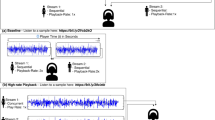Abstract
Disclosure of personal information is valuable to individuals, governments, and corporations. This experiment explores the role interface design plays in maximizing disclosure. Participants (N = 100) were asked to disclose personal information to a telephone-based speech user interface (SUI) in a 3 (recorded speech vs. synthesized speech vs. text-based interface) by 2 (gender of participant) by 2 (gender of voice) between-participants experiment (with no voice manipulation in the text conditions). Synthetic speech participants exhibited significantly less disclosure and less comfort with the system than text-based or recorded-speech participants. Females were more sensitive to differences between synthetic and recorded speech. There were significant interactions between modality and gender of speech, while there were no gender identification effects. Implications for the design of speech-based information-gathering systems are outlined.
Similar content being viewed by others
References
Blau, P. (1986). Exchange and Power in Social Life. New York: Transactions Publishers.
Beniger, J. (1986). The Control Revolution. Cambridge, MA: Harvard University Press.
Clark, H.H. (1996). Using Language. New York: Cambridge University Press.
Nass, C. and Gong, L. (2000). Social aspects of speech interfaces from an evolutionary perspective: Experimental research and design implications. Communications of the ACM, 43: 36-43.
Reeves, B. and Nass, C. (1996).The Media Equation: How People Treat Computers, Television, and New Media Like Real People and Places. New York: Cambridge University Press.
Lee, E.-J. and Nass, C. (2002). An experimental test of normative group influence and representation effects in computermediated communication: When interacting via computers differs from interacting with computers. Human Communication Research, 28:349-381.
Kamm, C., Walker, M., and Rabiner, L. (1997). The role of speech processing in human-computer intelligent communication. Presented at NSF Workshop on Human-Centered Systems: Information, Interactivity, and Intelligence.
Nass, C. and Lee, K.M. (2001). Does computer-synthesized speech manifest personality? Experimental tests of recognition, similarity-attraction, and consistency-attraction. Journal of Experimental Psychology: Applied, 7:171-181.
Nass, C., Foehr, U., Brave, S., and Somoza, M. (2001). The effects of emotion of voice in synthesized and recorded speech. Presented at Proceedings of the AAAI Symposium: Emotional and Intelligent II: The Tangled Knot of Social Cognition, North Falmouth, MA.
Tannen, D. (1996). Gender and Discourse. New York, Oxford: Oxford University Press.
Nass, C., Moon, Y., and Green, N. (1997). Are machines genderneutral? Gender-stereotypic responses to computers with voices. Journal of Applied Social Psychology, 27:864-876.
Lee, E.-J., Nass, C., and Brave, S. (2000). Can computer-generated speech have gender? An experimental test of gender stereotypes. Presented at CHI 2000. The Hague, The Netherlands.
Moon, Y. (1998). Impression management in computer-based interviews: The effects of input modality, output modality, and distance. Public Opinion Quarterly, 62:610-622.
Kroner, D.G. and Weekes, J.R. (1996). Balanced inventory of desirable responding: Factor structure, reliability, and validity with an offender sample. Personality and Individual Differences, 21:323-333.
Crowne, D. and Marlowe, D. (1964). The Approval Motive. New York: Wiley.
Bandura, A. (1997). Self-Efficacy: The Exercise of Control. San Francisco: W.H. Freeman and Co.
Gong, L. (2000). Pairing media-captured human versus computersynthesized humanoid faces and voices for talking heads: A consistency theory for interface agents. Communication. Stanford, CA: Stanford University.
Lee, K.M. (2002). Social-psychological origins of feelings of presence: Creating social presence with machine-generated voices. Presented at International Communication Association, Seoul, Korea.
Heeter, C. (1992). Being there: The subjective experience of presence. Presence: Teleoperators and Virtual Environment, 1:262-271.
Biocca, F. (1997). The cyborg's dilemma: Progressive embodiment in virtual environments. Journal of Computer-Mediated-Communication, 3. Available at <http://www.ascusc.org/jcmc/vol3/issue2>.
Argyle, M. and Cook, M. (1976). Gaze and Mutual Gaze. Cambridge: Cambridge University Press.
Mazanec, N. and McCall, G.J. (1976). Sex factors and allocation of attention in observing persons. Journal of Psychology, 93:175-180.
Hall, J.A. (1978). Gender effects in decoding nonverbal cues. Psychological Bulletin, 85:845-857.
Hall, J.A. (1984). Nonverbal Sex Differences: Communication Accuracy and Expressive Style. Baltimore, MD: Johns Hopkins University Press.
Eagly,A. (1983). Gender and social influence:Asocial psychological analysis. American Psychologist, 38:971-981.
Massaro, D.W. (1997). Perceiving Talking Faces: From Speech Perception to a Behavioral Principle. Cambridge, MA: MIT Press.
Cassell, J., Sullivan, J., Prevost, S., and Churchill, E. (2000). Embodied Conversational Agents. Cambridge, MA: MIT Press.
Panayiotou, G. (1999).Effects of self-focus and evaluation anxiety on task performance. West Lafayette, IN: Purdue University.
Rickenberg, R. and Reeves, B. (2000). The effects of animated characters on anxiety, task performance, and evaluations of user interfaces. Human Factors in Computing Systems: CHI'00 Conference Proceedings. New York: ACM Press, pp. 49-56.
Oviatt, S., DeAngeli, A., and Kuhn, K. (1997). Integration and synchronization of input modes during multimodal human-computer interaction. Proceedings of Conference on HumanFactors in Computing Systems (CHI'97). New York, NY: ACM Press, pp. 415-422.
Oviatt, S. (1999). Ten myths of multimodal interaction. Communications of the ACM 42:74-81.
Author information
Authors and Affiliations
Rights and permissions
About this article
Cite this article
Nass, C., Robles, E., Heenan, C. et al. Speech-Based Disclosure Systems: Effects of Modality, Gender of Prompt, and Gender of User. International Journal of Speech Technology 6, 113–121 (2003). https://doi.org/10.1023/A:1022378312670
Issue Date:
DOI: https://doi.org/10.1023/A:1022378312670




